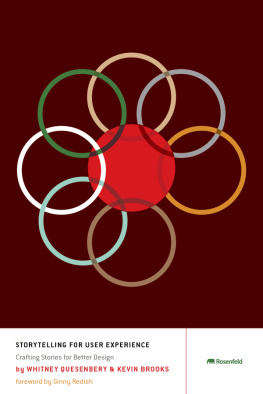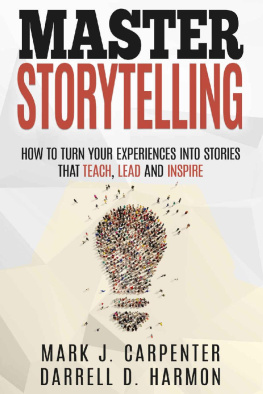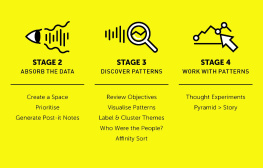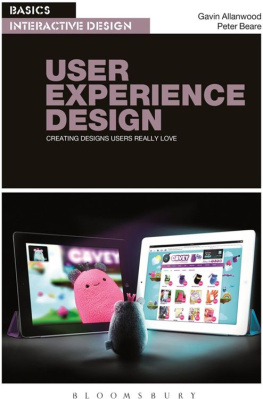Storytelling for User Experience
Crafting Stories for Better Design
Whitney Quesenbery
Kevin Brooks
 Rosenfeld Media, Brooklyn, New York
Rosenfeld Media, Brooklyn, New York
Rosenfeld Media, LLC
457 Third Street, #4R
Brooklyn, New York
11215 USA
On the Web: www.rosenfeldmedia.com
Please send errors to:
Publisher: Louis Rosenfeld
Editor: Marta Justak
Development Editor: David Moldawer
Interior Layout Tech: Danielle Foster
Cover Design: The Heads of State
Indexer: Nancy Guenther
Proofreader: Kezia Endsley
2010 Rosenfeld Media, LLC
All Rights Reserved
ISBN: 1-933820-03-9
ISBN-13: 978-1-933820-03-3
LCCN: 2010924283
Printed and bound in the United States of America
Dedication
This book is dedicated to
Brother BlueDr. Hugh Morgan Hill
who taught us that our stories have the power to change the world.
How to Use This Book
Who Should Read This Book?
This book is for any user experience practitioner or, really, anyone who designs, whether you are taking your first steps in the field or looking for ways to improve a long practice. If you are curious about storytelling as part of user experience design, we hope this book will give you a nudge to try it out. We've tried to cover the big points, but also to include practical ideas for using stories to enrich your practice and improve your work.
The stories in this book are real stories from real projects, as well as some examples created just for the book. Some are more polished; some are more ad-hoc and raw. There is not one style for the stories. We hope the range in this book will help you find your own storytelling voice.
If you are already a storyteller, this book can show you some new ways to use your storytelling skills.
As we worked on this project, we heard from many people in user experience who were thinking about stories. You will find many of their stories throughout the book as well.
If you...
- need to share research and design insights in a compelling and effective way
- struggle to communicate the meaning of a large body of data in a way that everyone just "gets"
- want to explore a new, innovative idea, and imagine its future
...then this book can help you, by showing you how and when to choose, create, and use stories.
What's in This Book?
The book is organized into three sections:
Section One: The first five chapters are a look at why stories can be useful in user experience and how they work. The section includes a chapter on some of the ethical issues you should consider when you are using stories based on real people.
Section Two. The middle section is an overview of the user experience process, looking at how stories can be a part of all stages of work, from user research to evaluation, including plenty of practical tips and examples.
Section Three. The last six chapters dive into the craft of creating and using stories, looking at how to address the right audience with the right story, the "ingredients" of a story (perspective, character, context, imagery, and language), the framework of structure and plot, and the different mediums you can use in the process of crafting effective stories.
What Comes with This Book?
This book's companion Web site
(  rosenfeldmedia.com/books/storytelling ) contains more stories and short articles about stories. You can also find a calendar of our workshops, talks about storytelling and storytelling performances, and a place to engage others in conversation. We've also made the book's Story Triangle diagrams and other illustrations available under a Creative Commons license for you to download and include in your own presentations. You can find these on Flickr at
rosenfeldmedia.com/books/storytelling ) contains more stories and short articles about stories. You can also find a calendar of our workshops, talks about storytelling and storytelling performances, and a place to engage others in conversation. We've also made the book's Story Triangle diagrams and other illustrations available under a Creative Commons license for you to download and include in your own presentations. You can find these on Flickr at  www.flickr.com/photos/rosenfeldmedia/sets/ , or you can just double-click the pushpin next to the image to see them in high resolution.
www.flickr.com/photos/rosenfeldmedia/sets/ , or you can just double-click the pushpin next to the image to see them in high resolution.
Frequently AskedQuestions
Why stories in user experience design?
Stories have always been part of user experience design as scenarios, storyboard, flow charts, personas, and every other technique that we use to communicate how (and why) a new design will work. As a part of user experience design, stories serve to ground the work in a real context by connecting design ideas to the people who will use the product. This book starts with a look at how and why stories are so effective. See Chapters .
Is storytelling a new UX methodology?
No. We are not here to promote a new methodology based on using stories. Whether you believe in user-centered design, goals-based design, or even a more technical approach like domain-driven design, stories have a place in your work. Stories can be a part of almost any user experience activity. The middle section of the book is arranged in a loose lifecycle, so you can dive in at whatever point you are in your current projects.
See Chapters .
Can I start using stories in the middle of a project?
Yes. Although user experience is improved by having good user research (and the stories you will collect), there are many reasons why you might find yourself working on a design or running a usability evaluation without a good collection of stories to draw on. The chapter on using stories in the design process includes several techniques for working with, or creating, stories. See Chapter .
I don't think I tell stories well.
What do I do?
You may not think you tell stories, but you probably already do. Most of us tell stories as a way to explain a perspective on a problem or describe an event. The goal of this book is to help you learn to use stories in a new way. We hope the varied stories in this book will be an inspiration. Your storytelling will improve with each telling opportunity. See Chapter .
How do I create a good story?
Creating a story isn't hard. Your first ones may feel awkward, but storytelling gets easierand your stories get betterwith practice. Storytelling is a craft as much as an art. If you start by knowing your audience, add character, perspective, context, and imagery, and put it all together within a structure, it will all come together. See Chapters .
How much does the audience matter?
Knowing your audience is critical. Whether you can plan in advance, or have to adjust on the fly, you can't tell a good story unless you can get the audience involved. After all, the goal of the story isn't to tell it, but for the audience to hear it and take away something new. See Chapters .
Is it OK to use other people's stories?
When we do user research, one of our goals is to bring back a useful picture of the people we design for. Telling their stories is one way to share what you have learned. But you have to remember that they are human beings who must be treated ethically. See Chapters .
Is this a book about performing stories?
Not really. For performancestorytelling, the crafting and telling of stories is a goal in itself. Noris the book about scriptwriting or writing short fiction. While some of thestory structures and ingredients covered in the last section can help adddrama to stories, that is not our focus. When we use stories in userexperience practice, we borrow from these worlds, but put them to use in newways. See Chapter 15.
Do you cover storytelling in games?
This is also not a book about narrative hypertext, games, interactive fiction, virtual reality, or immersive interfaces where stories and storytelling are a central feature of the user interface. Although we believe that every interaction tells a story (even if only a mundane one), this book is not primarily about how to weave stories into a digital interactive experience.











 Rosenfeld Media, Brooklyn, New York
Rosenfeld Media, Brooklyn, New York